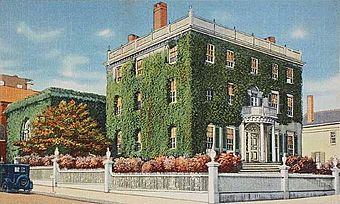McLellan-Sweat Mansion facts for kids
|
McLellan-Sweat Mansion
|
|
|
U.S. Historic district
Contributing property |
|
 |
|
| Location | Portland, Maine |
|---|---|
| Built | 1800-1801 |
| Architect | John Kimball Sr. |
| Architectural style | Federal |
| Part of | Spring Street Historic District (ID70000043) |
| NRHP reference No. | 70000073 |
Quick facts for kids Significant dates |
|
| Added to NRHP | March 5, 1970 |
| Designated NHL | December 30, 1970 |
| Designated CP | April 3, 1970 |
The McLellan-Sweat Mansion, also known as The McLellan House, is a very old and important house in Portland, Maine. Today, it's a historic house museum, which means you can visit it to learn about the past. It's part of the Portland Museum of Art and sits behind the main museum building. This beautiful brick house was built a long time ago, between 1800 and 1801. Because it's so well-preserved and shows off the "Federal style" of architecture, it was named a National Historic Landmark in 1970. This means it's a special place recognized for its history and design.
Contents
What Does the Mansion Look Like?
The McLellan-Sweat Mansion is located in downtown Portland. It's at the corner of High Street and Spring Street. You can get to it through the main entrance of the Portland Museum of Art.
Outside the Mansion
This house has three stories and is made of brick. It has a low, sloped roof and a strong granite base. The bricks are laid in a special pattern called "Flemish bond." This pattern makes the walls very strong and look nice.
The front of the house faces Spring Street. It has five sections, or "bays." The main door is in the middle. It has a round porch, called a "portico," with columns that look like the ancient Greek Doric style. Above the porch is a railing, or "balustrade." The doorway also has narrow windows on the sides and a fan-shaped window above it.
On the second floor, right above the main door, there's a special window. It's called a "Palladian window." This type of window has a tall arch in the middle and two smaller, flat-topped windows on each side. The roof has decorative brackets and another low railing with urns on top.
Inside the Mansion
When you go inside, you'll find a central hallway. This hallway leads to different rooms on the first floor. These rooms have beautiful wooden details and carvings. They show off the high-quality craftsmanship from when the house was built.
History of the McLellan-Sweat Mansion
The McLellan-Sweat Mansion has a long and interesting history. It has been owned by several important people and has changed over the years.
Who Built It?
The house was built between 1800 and 1801. It was made for a wealthy man named Major Hugh McLellan. He was a "shipping magnate," which means he made a lot of money from ships and trade. The house was designed by an architect named John Kimball Sr.. Building this grand house cost $20,000, which was a huge amount of money back then!
Later Owners and the Museum
After Major McLellan, the house had a few different owners. In 1880, a man named Lorenzo De Medici Sweat bought the property. When he passed away, his wife left the house to the Portland Society of Art in 1908. This society is now known as the Portland Museum of Art.
In 1911, new art galleries were added behind the house. These were called the L. D. M. Sweat Memorial Galleries. They were designed by architect John Calvin Stevens and connected to the house by a hallway.
Changes and Restoration
Over the years, the house had some changes. In 1957, two special fireplace mantels were added. They came from another old house, the 1805 Commodore Edward Preble House. These new mantels replaced the original ones that were lost during a "Greek Revival" style update to the house.
In 1970, the McLellan-Sweat Mansion was added to the National Register of Historic Places. It was also named a National Historic Landmark. This shows how important the house is to American history and architecture.
In 1983, a new building for the museum opened. It was designed by Henry N. Cobb and extended the museum to a new entrance. The McLellan House itself was carefully restored and reopened in 2002. Today, it continues to be a wonderful place to learn about the past.
See also



